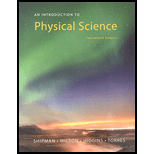
Bundle: An Introduction to Physical Science, 14th Loose-leaf Version + WebAssign Printed Access Card, Single Term. Shipman/Wilson/Higgins/Torres
14th Edition
ISBN: 9781305719057
Author: James Shipman, Jerry D. Wilson, Charles A. Higgins, Omar Torres
Publisher: Cengage Learning
expand_more
expand_more
format_list_bulleted
Question
Chapter 11, Problem 5E
To determine
Whether the solution obtained by dissolving
100 g 100 g 40 ° C
Expert Solution & Answer
Trending nowThis is a popular solution!

Chapter 11 Solutions
Bundle: An Introduction to Physical Science, 14th Loose-leaf Version + WebAssign Printed Access Card, Single Term. Shipman/Wilson/Higgins/Torres
Ch. 11.1 - Prob. 1PQCh. 11.1 - Prob. 2PQCh. 11.2 - How many naturally occurring elements are there?Ch. 11.2 - Prob. 2PQCh. 11.3 - What is the most common element in the Earths...Ch. 11.3 - Prob. 2PQCh. 11.4 - Prob. 1PQCh. 11.4 - Prob. 2PQCh. 11.4 - Prob. 11.1CECh. 11.5 - Prob. 1PQ
Ch. 11.5 - Prob. 2PQCh. 11.5 - Prob. 11.2CECh. 11.6 - Prob. 1PQCh. 11.6 - Which group is composed of monatomic gases, and...Ch. 11.6 - Prob. 11.3CECh. 11 - Prob. AMCh. 11 - Prob. BMCh. 11 - Prob. CMCh. 11 - Prob. DMCh. 11 - Prob. EMCh. 11 - Prob. FMCh. 11 - Prob. GMCh. 11 - Prob. HMCh. 11 - Prob. IMCh. 11 - Prob. JMCh. 11 - Prob. KMCh. 11 - Prob. LMCh. 11 - Prob. MMCh. 11 - Prob. NMCh. 11 - Prob. OMCh. 11 - Prob. PMCh. 11 - Prob. QMCh. 11 - Prob. RMCh. 11 - Prob. SMCh. 11 - Prob. TMCh. 11 - Prob. UMCh. 11 - Prob. VMCh. 11 - Prob. WMCh. 11 - Prob. XMCh. 11 - Prob. YMCh. 11 - Prob. 1MCCh. 11 - A solute crystal dissolves when added to a...Ch. 11 - Prob. 3MCCh. 11 - Which of these is a synthetic element? (11.2) (a)...Ch. 11 - Prob. 5MCCh. 11 - Prob. 6MCCh. 11 - Prob. 7MCCh. 11 - Which one of these elements has the greatest...Ch. 11 - Prob. 9MCCh. 11 - Which of these is the technical name for Ag3PO4?...Ch. 11 - Which of these is the technical name for SF4?...Ch. 11 - Prob. 12MCCh. 11 - Prob. 1FIBCh. 11 - Prob. 2FIBCh. 11 - Hot water dissolves ____ solute than the same...Ch. 11 - Prob. 4FIBCh. 11 - Prob. 5FIBCh. 11 - Prob. 6FIBCh. 11 - Prob. 7FIBCh. 11 - Prob. 8FIBCh. 11 - Prob. 9FIBCh. 11 - Prob. 10FIBCh. 11 - Prob. 11FIBCh. 11 - Prob. 12FIBCh. 11 - Prob. 1SACh. 11 - Prob. 2SACh. 11 - Prob. 3SACh. 11 - When solid copper and zinc are mixed to form the...Ch. 11 - What type of process is involved in going from...Ch. 11 - What characteristic distinguishes an element from...Ch. 11 - Prob. 7SACh. 11 - Prob. 8SACh. 11 - Why does a carbonated beverage container sizzle...Ch. 11 - Prob. 10SACh. 11 - Prob. 11SACh. 11 - Prob. 12SACh. 11 - Prob. 13SACh. 11 - Prob. 14SACh. 11 - Prob. 15SACh. 11 - Prob. 16SACh. 11 - Prob. 17SACh. 11 - What formal term is applied to (a) the horizontal...Ch. 11 - Why are chemists so interested in the number of...Ch. 11 - Prob. 20SACh. 11 - Prob. 21SACh. 11 - Prob. 22SACh. 11 - Prob. 23SACh. 11 - Prob. 24SACh. 11 - Prob. 25SACh. 11 - Prob. 26SACh. 11 - Why is it necessary to use Greek prefixes when...Ch. 11 - Prob. 28SACh. 11 - Prob. 29SACh. 11 - Prob. 30SACh. 11 - Prob. 31SACh. 11 - Prob. 32SACh. 11 - Prob. 33SACh. 11 - Prob. 34SACh. 11 - Prob. 1VCCh. 11 - Prob. 1AYKCh. 11 - Prob. 2AYKCh. 11 - Prob. 3AYKCh. 11 - Prob. 4AYKCh. 11 - Prob. 5AYKCh. 11 - Prob. 6AYKCh. 11 - Consider the hypothetical case in which the charge...Ch. 11 - Prob. 8AYKCh. 11 - Prob. 1ECh. 11 - Classify each of the following materials as an...Ch. 11 - Prob. 3ECh. 11 - Prob. 4ECh. 11 - Prob. 5ECh. 11 - Prob. 6ECh. 11 - Prob. 7ECh. 11 - Prob. 8ECh. 11 - Prob. 9ECh. 11 - Give the name of each element: (a) Sb, (b) As, (c)...Ch. 11 - Prob. 11ECh. 11 - Prob. 12ECh. 11 - Prob. 13ECh. 11 - Prob. 14ECh. 11 - Prob. 15ECh. 11 - Prob. 16ECh. 11 - Prob. 17ECh. 11 - Prob. 18ECh. 11 - Prob. 19ECh. 11 - Prob. 20ECh. 11 - Prob. 21ECh. 11 - Prob. 22ECh. 11 - Prob. 23ECh. 11 - Prob. 24ECh. 11 - Prob. 25ECh. 11 - Prob. 26ECh. 11 - Prob. 27ECh. 11 - Name each of these common acids: (a) H3PO4(aq),...Ch. 11 - Prob. 29ECh. 11 - Prob. 30ECh. 11 - Prob. 31ECh. 11 - Prob. 32E
Knowledge Booster
Learn more about
Need a deep-dive on the concept behind this application? Look no further. Learn more about this topic, physics and related others by exploring similar questions and additional content below.The Laws of Thermodynamics, Entropy, and Gibbs Free Energy; Author: Professor Dave Explains;https://www.youtube.com/watch?v=8N1BxHgsoOw;License: Standard YouTube License, CC-BY